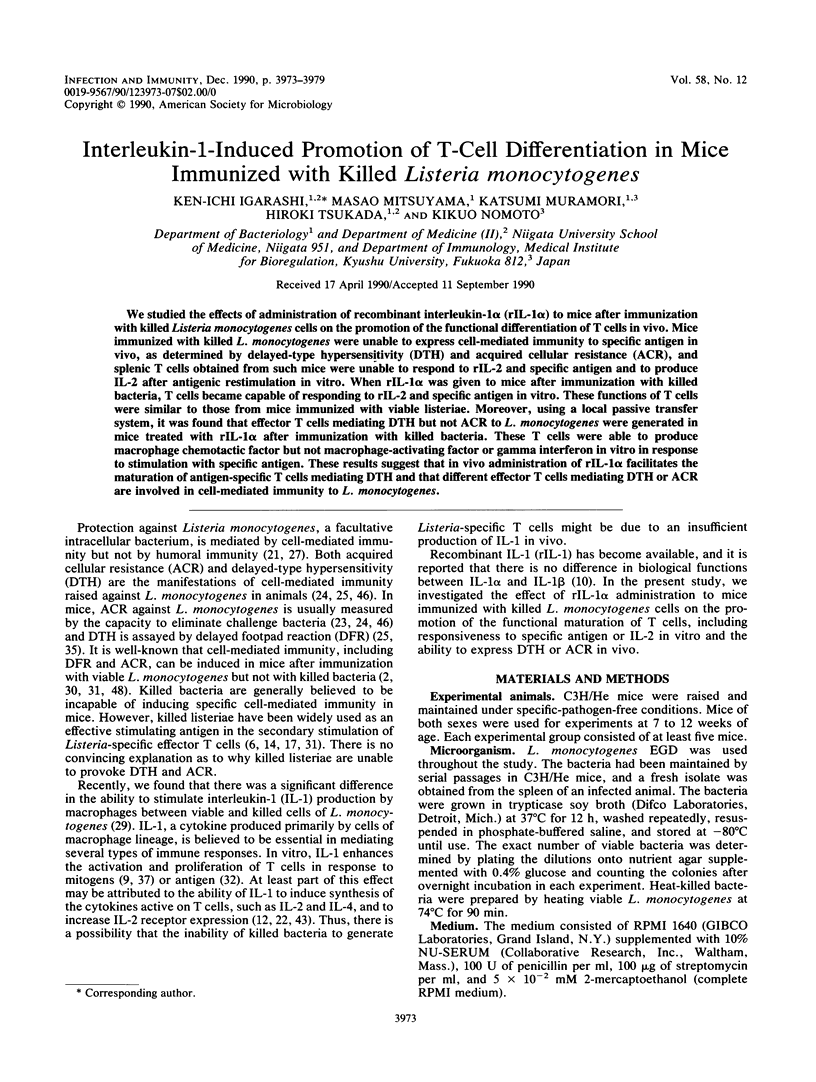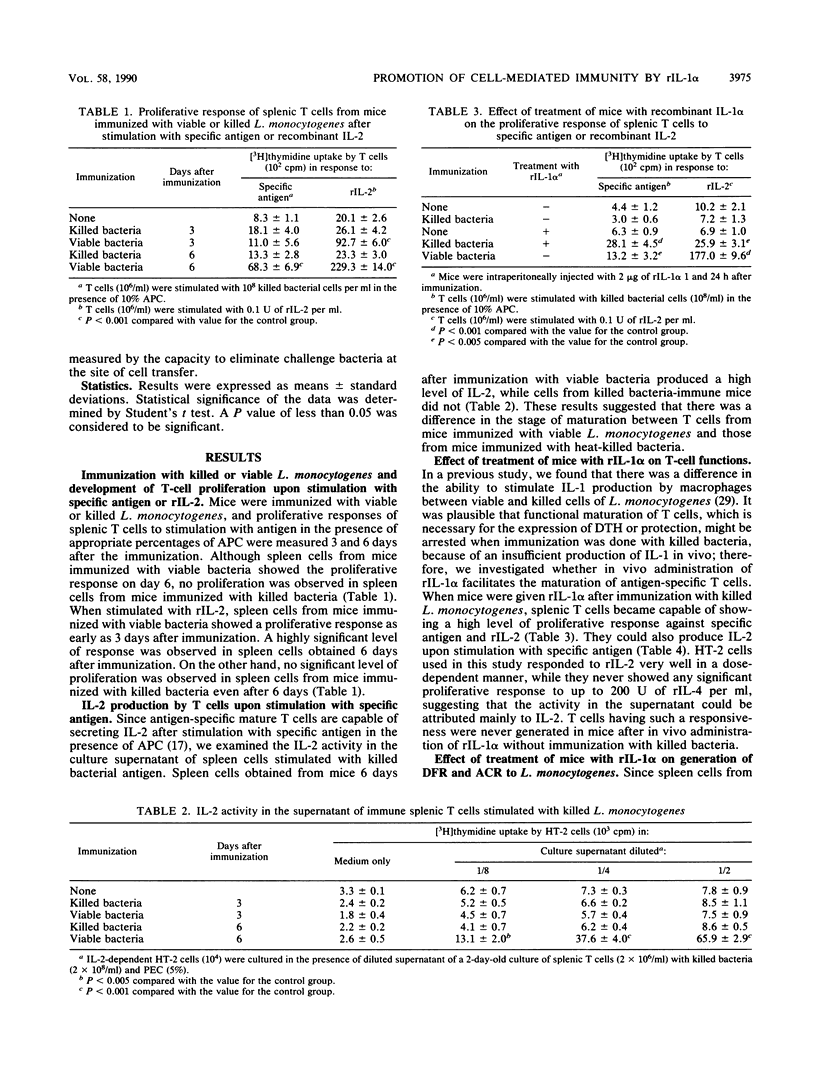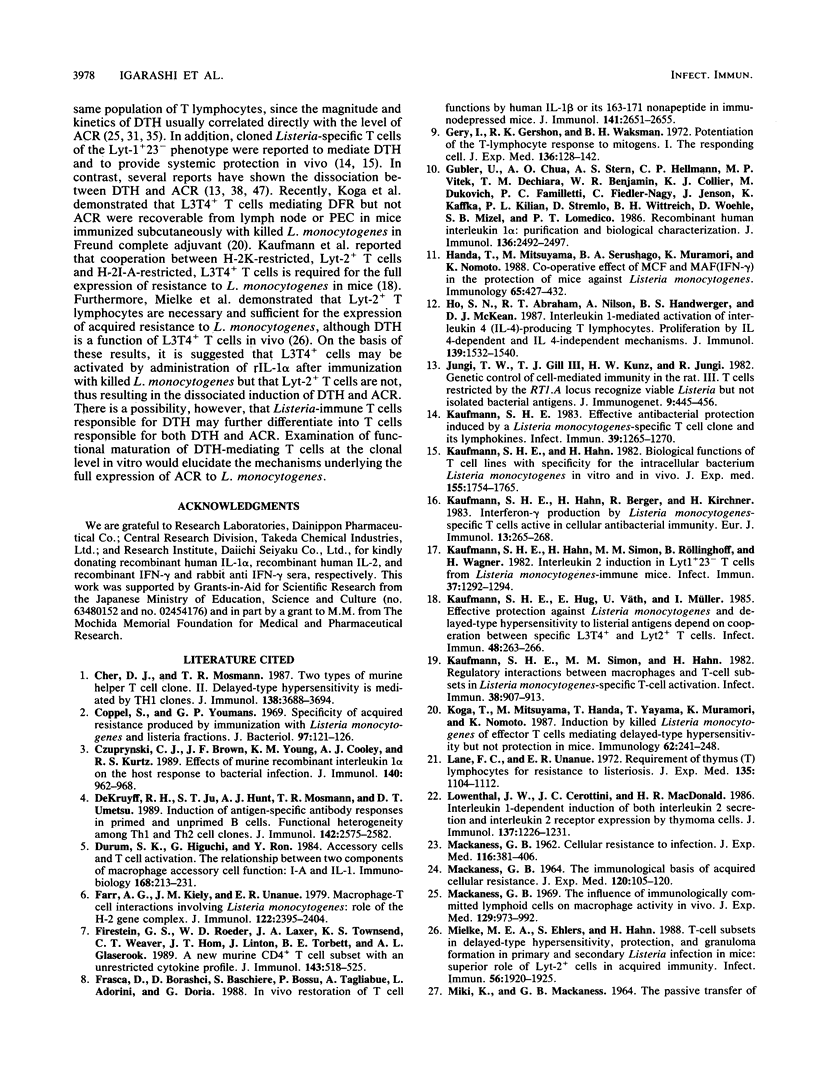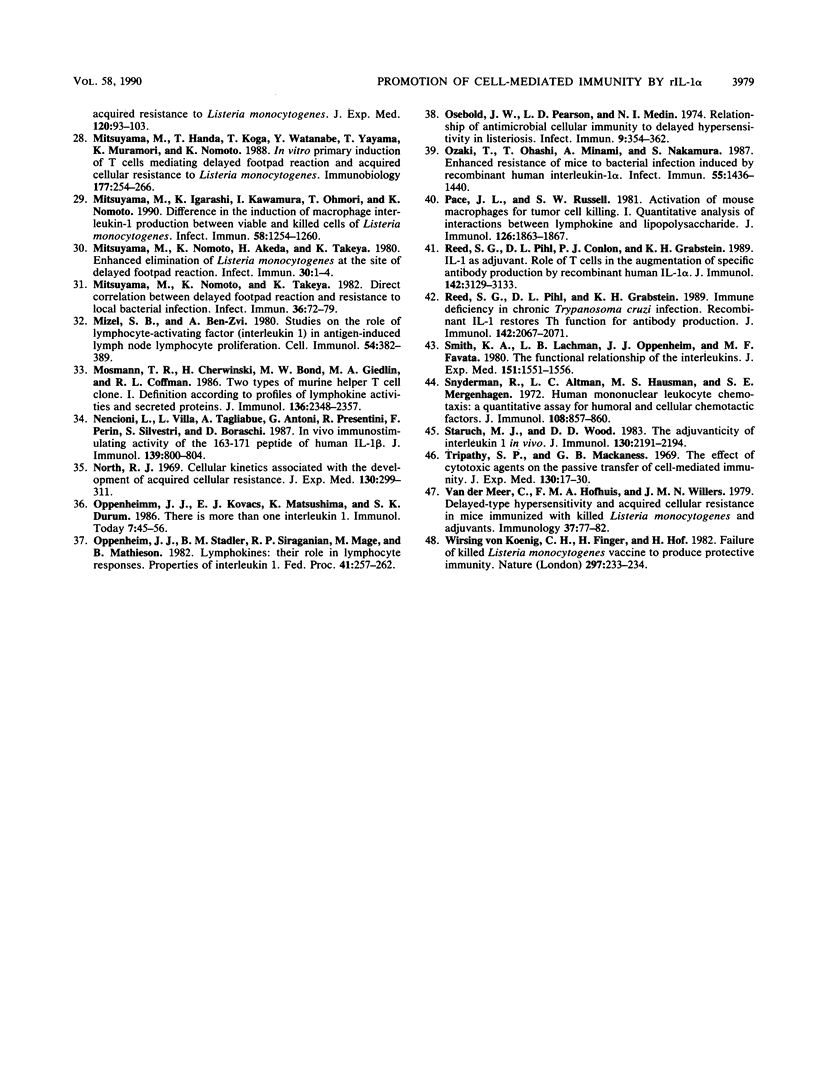Abstract
We studied the effects of administration of recombinant interleukin-1 alpha (rIL-1 alpha) to mice after immunization with killed Listeria monocytogenes cells on the promotion of the functional differentiation of T cells in vivo. Mice immunized with killed L. monocytogenes were unable to express cell-mediated immunity to specific antigen in vivo, as determined by delayed-type hypersensitivity (DTH) and acquired cellular resistance (ACR), and splenic T cells obtained from such mice were unable to respond to rIL-2 and specific antigen and to produce IL-2 after antigenic restimulation in vitro. When rIL-1 alpha was given to mice after immunization with killed bacteria. T cells became capable of responding to rIL-2 and specific antigen in vitro. These functions of T cells were similar to those from mice immunized with viable listeriae. Moreover, using a local passive transfer system, it was found that effector T cells mediating DTH but not ACR to L. monocytogenes were generated in mice treated with rIL-1 alpha after immunization with killed bacteria. These T cells were able to produce macrophage chemotactic factor but not macrophage-activating factor or gamma interferon in vitro in response to stimulation with specific antigen. These results suggest that in vivo administration of rIL-1 alpha facilitates the maturation of antigen-specific T cells mediating DTH and that different effector T cells mediating DTH or ACR are involved in cell-mediated immunity to L. monocytogenes.
Full text
PDF






Selected References
These references are in PubMed. This may not be the complete list of references from this article.
- Cher D. J., Mosmann T. R. Two types of murine helper T cell clone. II. Delayed-type hypersensitivity is mediated by TH1 clones. J Immunol. 1987 Jun 1;138(11):3688–3694. [PubMed] [Google Scholar]
- Coppel S., Youmans G. P. Specificity of Acquired Resistance Produced by Immunization with Listeria monocytogenes and Listeria Fractions. J Bacteriol. 1969 Jan;97(1):121–126. doi: 10.1128/jb.97.1.121-126.1969. [DOI] [PMC free article] [PubMed] [Google Scholar]
- Czuprynski C. J., Brown J. F., Young K. M., Cooley A. J., Kurtz R. S. Effects of murine recombinant interleukin 1 alpha on the host response to bacterial infection. J Immunol. 1988 Feb 1;140(3):962–968. [PubMed] [Google Scholar]
- DeKruyff R. H., Ju S. T., Hunt A. J., Mosmann T. R., Umetsu D. T. Induction of antigen-specific antibody responses in primed and unprimed B cells. Functional heterogeneity among Th1 and Th2 T cell clones. J Immunol. 1989 Apr 15;142(8):2575–2582. [PubMed] [Google Scholar]
- Durum S. K., Higuchi C., Ron Y. Accessory cells and T cell activation. The relationship between two components of macrophage accessory cell function: I-A and IL1. Immunobiology. 1984 Dec;168(3-5):213–231. doi: 10.1016/S0171-2985(84)80112-6. [DOI] [PubMed] [Google Scholar]
- Farr A. G., Kiely J. M., Unanue E. R. Macrophage-T cell interactions involving Listeria monocytogenes--role of the H-2 gene complex. J Immunol. 1979 Jun;122(6):2395–2404. [PubMed] [Google Scholar]
- Firestein G. S., Roeder W. D., Laxer J. A., Townsend K. S., Weaver C. T., Hom J. T., Linton J., Torbett B. E., Glasebrook A. L. A new murine CD4+ T cell subset with an unrestricted cytokine profile. J Immunol. 1989 Jul 15;143(2):518–525. [PubMed] [Google Scholar]
- Frasca D., Boraschi D., Baschieri S., Bossu P., Tagliabue A., Adorini L., Doria G. In vivo restoration of T cell functions by human IL-1 beta or its 163-171 nonapeptide in immunodepressed mice. J Immunol. 1988 Oct 15;141(8):2651–2655. [PubMed] [Google Scholar]
- Gery I., Gershon R. K., Waksman B. H. Potentiation of the T-lymphocyte response to mitogens. I. The responding cell. J Exp Med. 1972 Jul 1;136(1):128–142. doi: 10.1084/jem.136.1.128. [DOI] [PMC free article] [PubMed] [Google Scholar]
- Gubler U., Chua A. O., Stern A. S., Hellmann C. P., Vitek M. P., DeChiara T. M., Benjamin W. R., Collier K. J., Dukovich M., Familletti P. C. Recombinant human interleukin 1 alpha: purification and biological characterization. J Immunol. 1986 Apr 1;136(7):2492–2497. [PubMed] [Google Scholar]
- Handa T., Mitsuyama M., Serushago B. A., Muramori K., Nomoto K. Co-operative effect of MCF and MAF(IFN-gamma) in the protection of mice against Listeria monocytogenes. Immunology. 1988 Nov;65(3):427–432. [PMC free article] [PubMed] [Google Scholar]
- Ho S. N., Abraham R. T., Nilson A., Handwerger B. S., McKean D. J. Interleukin 1-mediated activation of interleukin 4 (IL 4)-producing T lymphocytes. Proliferation by IL 4-dependent and IL 4-independent mechanisms. J Immunol. 1987 Sep 1;139(5):1532–1540. [PubMed] [Google Scholar]
- Jungi T. W., Gill T. J., 3rd, Kunz H. W., Jungi R. Genetic control of cell-mediated immunity in the rat. III. T cells restricted by the RT1.A locus recognize viable Listeria but not isolated bacterial antigens. J Immunogenet. 1982 Dec;9(6):445–456. doi: 10.1111/j.1744-313x.1982.tb01006.x. [DOI] [PubMed] [Google Scholar]
- Kaufmann S. H. Effective antibacterial protection induced by a Listeria monocytogenes-specific T cell clone and its lymphokines. Infect Immun. 1983 Mar;39(3):1265–1270. doi: 10.1128/iai.39.3.1265-1270.1983. [DOI] [PMC free article] [PubMed] [Google Scholar]
- Kaufmann S. H., Hahn H., Berger R., Kirchner H. Interferon-gamma production by Listeria monocytogenes-specific T cells active in cellular antibacterial immunity. Eur J Immunol. 1983 Mar;13(3):265–268. doi: 10.1002/eji.1830130318. [DOI] [PubMed] [Google Scholar]
- Kaufmann S. H., Hahn H. Biological functions of t cell lines with specificity for the intracellular bacterium Listeria monocytogenes in vitro and in vivo. J Exp Med. 1982 Jun 1;155(6):1754–1765. doi: 10.1084/jem.155.6.1754. [DOI] [PMC free article] [PubMed] [Google Scholar]
- Kaufmann S. H., Hahn H., Simon M. M., Röllinghoff M., Wagner H. Interleukin 2 induction in Lyt 1+ 23- T cells from Listeria monocytogenes-immune mice. Infect Immun. 1982 Sep;37(3):1292–1294. doi: 10.1128/iai.37.3.1292-1294.1982. [DOI] [PMC free article] [PubMed] [Google Scholar]
- Kaufmann S. H., Hug E., Väth U., Müller I. Effective protection against Listeria monocytogenes and delayed-type hypersensitivity to listerial antigens depend on cooperation between specific L3T4+ and Lyt 2+ T cells. Infect Immun. 1985 Apr;48(1):263–266. doi: 10.1128/iai.48.1.263-266.1985. [DOI] [PMC free article] [PubMed] [Google Scholar]
- Kaufmann S. H., Simon M. M., Hahn H. Regulatory interactions between macrophages and T-cell subsets in Listeria monocytogenes-specific T-cell activation. Infect Immun. 1982 Dec;38(3):907–913. doi: 10.1128/iai.38.3.907-913.1982. [DOI] [PMC free article] [PubMed] [Google Scholar]
- Koga T., Mitsuyama M., Handa T., Yayama T., Muramori K., Nomoto K. Induction by killed Listeria monocytogenes of effector T cells mediating delayed-type hypersensitivity but not protection in mice. Immunology. 1987 Oct;62(2):241–248. [PMC free article] [PubMed] [Google Scholar]
- Lane F. C., Unanue E. R. Requirement of thymus (T) lymphocytes for resistance to listeriosis. J Exp Med. 1972 May 1;135(5):1104–1112. doi: 10.1084/jem.135.5.1104. [DOI] [PMC free article] [PubMed] [Google Scholar]
- Lowenthal J. W., Cerottini J. C., MacDonald H. R. Interleukin 1-dependent induction of both interleukin 2 secretion and interleukin 2 receptor expression by thymoma cells. J Immunol. 1986 Aug 15;137(4):1226–1231. [PubMed] [Google Scholar]
- MACKANESS G. B. Cellular resistance to infection. J Exp Med. 1962 Sep 1;116:381–406. doi: 10.1084/jem.116.3.381. [DOI] [PMC free article] [PubMed] [Google Scholar]
- MACKANESS G. B. THE IMMUNOLOGICAL BASIS OF ACQUIRED CELLULAR RESISTANCE. J Exp Med. 1964 Jul 1;120:105–120. doi: 10.1084/jem.120.1.105. [DOI] [PMC free article] [PubMed] [Google Scholar]
- MIKI K., MACKANESS G. B. THE PASSIVE TRANSFER OF ACQUIRED RESISTANCE TO LISTERIA MONOCYTOGENES. J Exp Med. 1964 Jul 1;120:93–103. doi: 10.1084/jem.120.1.93. [DOI] [PMC free article] [PubMed] [Google Scholar]
- Mackaness G. B. The influence of immunologically committed lymphoid cells on macrophage activity in vivo. J Exp Med. 1969 May 1;129(5):973–992. doi: 10.1084/jem.129.5.973. [DOI] [PMC free article] [PubMed] [Google Scholar]
- Mielke M. E., Ehlers S., Hahn H. T-cell subsets in delayed-type hypersensitivity, protection, and granuloma formation in primary and secondary Listeria infection in mice: superior role of Lyt-2+ cells in acquired immunity. Infect Immun. 1988 Aug;56(8):1920–1925. doi: 10.1128/iai.56.8.1920-1925.1988. [DOI] [PMC free article] [PubMed] [Google Scholar]
- Mitsuyama M., Handa T., Koga T., Watanabe Y., Yayama T., Muramori K., Nomoto K. In vitro primary induction of T cells mediating delayed footpad reaction and acquired cellular resistance to Listeria monocytogenes. Immunobiology. 1988 Jul;177(3):254–266. doi: 10.1016/S0171-2985(88)80045-7. [DOI] [PubMed] [Google Scholar]
- Mitsuyama M., Igarashi K., Kawamura I., Ohmori T., Nomoto K. Difference in the induction of macrophage interleukin-1 production between viable and killed cells of Listeria monocytogenes. Infect Immun. 1990 May;58(5):1254–1260. doi: 10.1128/iai.58.5.1254-1260.1990. [DOI] [PMC free article] [PubMed] [Google Scholar]
- Mitsuyama M., Nomoto K., Akeda H., Takeya K. Enhanced elimination of Listeria monocytogenes at the site of delayed footpad reaction. Infect Immun. 1980 Oct;30(1):1–4. doi: 10.1128/iai.30.1.1-4.1980. [DOI] [PMC free article] [PubMed] [Google Scholar]
- Mitsuyama M., Nomoto K., Takeya K. Direct correlation between delayed footpad reaction and resistance to local bacterial infection. Infect Immun. 1982 Apr;36(1):72–79. doi: 10.1128/iai.36.1.72-79.1982. [DOI] [PMC free article] [PubMed] [Google Scholar]
- Mizel S. B., Ben-Zvi A. Studies on the role of lymphocyte-activating factor (Interleukin 1) in antigen-induced lymph node lymphocyte proliferation. Cell Immunol. 1980 Sep 1;54(2):382–389. doi: 10.1016/0008-8749(80)90218-x. [DOI] [PubMed] [Google Scholar]
- Mosmann T. R., Cherwinski H., Bond M. W., Giedlin M. A., Coffman R. L. Two types of murine helper T cell clone. I. Definition according to profiles of lymphokine activities and secreted proteins. J Immunol. 1986 Apr 1;136(7):2348–2357. [PubMed] [Google Scholar]
- Nencioni L., Villa L., Tagliabue A., Antoni G., Presentini R., Perin F., Silvestri S., Boraschi D. In vivo immunostimulating activity of the 163-171 peptide of human IL-1 beta. J Immunol. 1987 Aug 1;139(3):800–804. [PubMed] [Google Scholar]
- North R. J. Cellular kinetics associated with the development of acquired cellular resistance. J Exp Med. 1969 Aug 1;130(2):299–314. doi: 10.1084/jem.130.2.299. [DOI] [PMC free article] [PubMed] [Google Scholar]
- Oppenheim J. J., Stadler B. M., Siraganian R. P., Mage M., Mathieson B. Lymphokines: their role in lymphocyte responses. Properties of interleukin 1. Fed Proc. 1982 Feb;41(2):257–262. [PubMed] [Google Scholar]
- Osebold J. W., Pearson L. D., Medin N. I. Relationship of antimicrobial cellular immunity to delayed hypersensitivity in Listeriosis. Infect Immun. 1974 Feb;9(2):354–362. doi: 10.1128/iai.9.2.354-362.1974. [DOI] [PMC free article] [PubMed] [Google Scholar]
- Ozaki Y., Ohashi T., Minami A., Nakamura S. Enhanced resistance of mice to bacterial infection induced by recombinant human interleukin-1a. Infect Immun. 1987 Jun;55(6):1436–1440. doi: 10.1128/iai.55.6.1436-1440.1987. [DOI] [PMC free article] [PubMed] [Google Scholar]
- Pace J. L., Russell S. W. Activation of mouse macrophages for tumor cell killing. I. Quantitative analysis of interactions between lymphokine and lipopolysaccharide. J Immunol. 1981 May;126(5):1863–1867. [PubMed] [Google Scholar]
- Reed S. G., Pihl D. L., Conlon P. J., Grabstein K. H. IL-1 as adjuvant. Role of T cells in the augmentation of specific antibody production by recombinant human IL-1 alpha. J Immunol. 1989 May 1;142(9):3129–3133. [PubMed] [Google Scholar]
- Reed S. G., Pihl D. L., Grabstein K. H. Immune deficiency in chronic Trypanosoma cruzi infection. Recombinant IL-1 restores Th function for antibody production. J Immunol. 1989 Mar 15;142(6):2067–2071. [PubMed] [Google Scholar]
- Smith K. A., Lachman L. B., Oppenheim J. J., Favata M. F. The functional relationship of the interleukins. J Exp Med. 1980 Jun 1;151(6):1551–1556. doi: 10.1084/jem.151.6.1551. [DOI] [PMC free article] [PubMed] [Google Scholar]
- Snyderman R., Altman L. C., Hausman M. S., Mergenhagen S. E. Human mononuclear leukocyte chemotaxis: a quantitative assay for humoral and cellular chemotactic factors. J Immunol. 1972 Mar;108(3):857–860. [PubMed] [Google Scholar]
- Staruch M. J., Wood D. D. The adjuvanticity of interleukin 1 in vivo. J Immunol. 1983 May;130(5):2191–2194. [PubMed] [Google Scholar]
- Tripathy S. P., Mackaness G. B. The effect of cytotoxic agents on the passive transfer of cell-mediated immunity. J Exp Med. 1969 Jul 1;130(1):17–30. doi: 10.1084/jem.130.1.17. [DOI] [PMC free article] [PubMed] [Google Scholar]
- Van Der Meer C., Hofhuis F. M., Willers J. M. Delayed-type hypersensitivity and acquired cellular resistance in mice immunized with killed Listeria monocytogenes and adjuvants. Immunology. 1979 May;37(1):77–82. [PMC free article] [PubMed] [Google Scholar]
- von Koenig C. H., Finger H., Hof H. Failure of killed Listeria monocytogenes vaccine to produce protective immunity. Nature. 1982 May 20;297(5863):233–234. doi: 10.1038/297233a0. [DOI] [PubMed] [Google Scholar]


